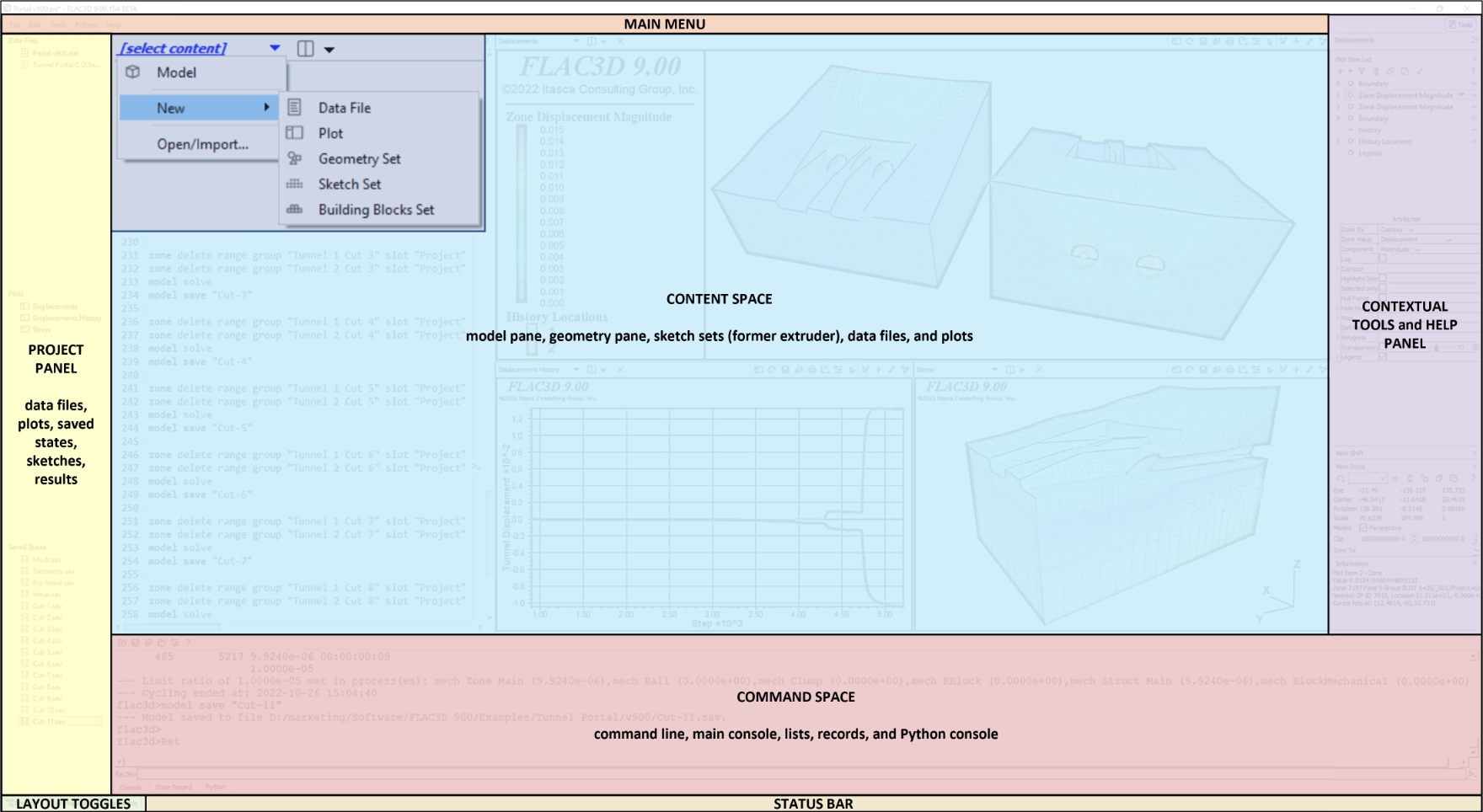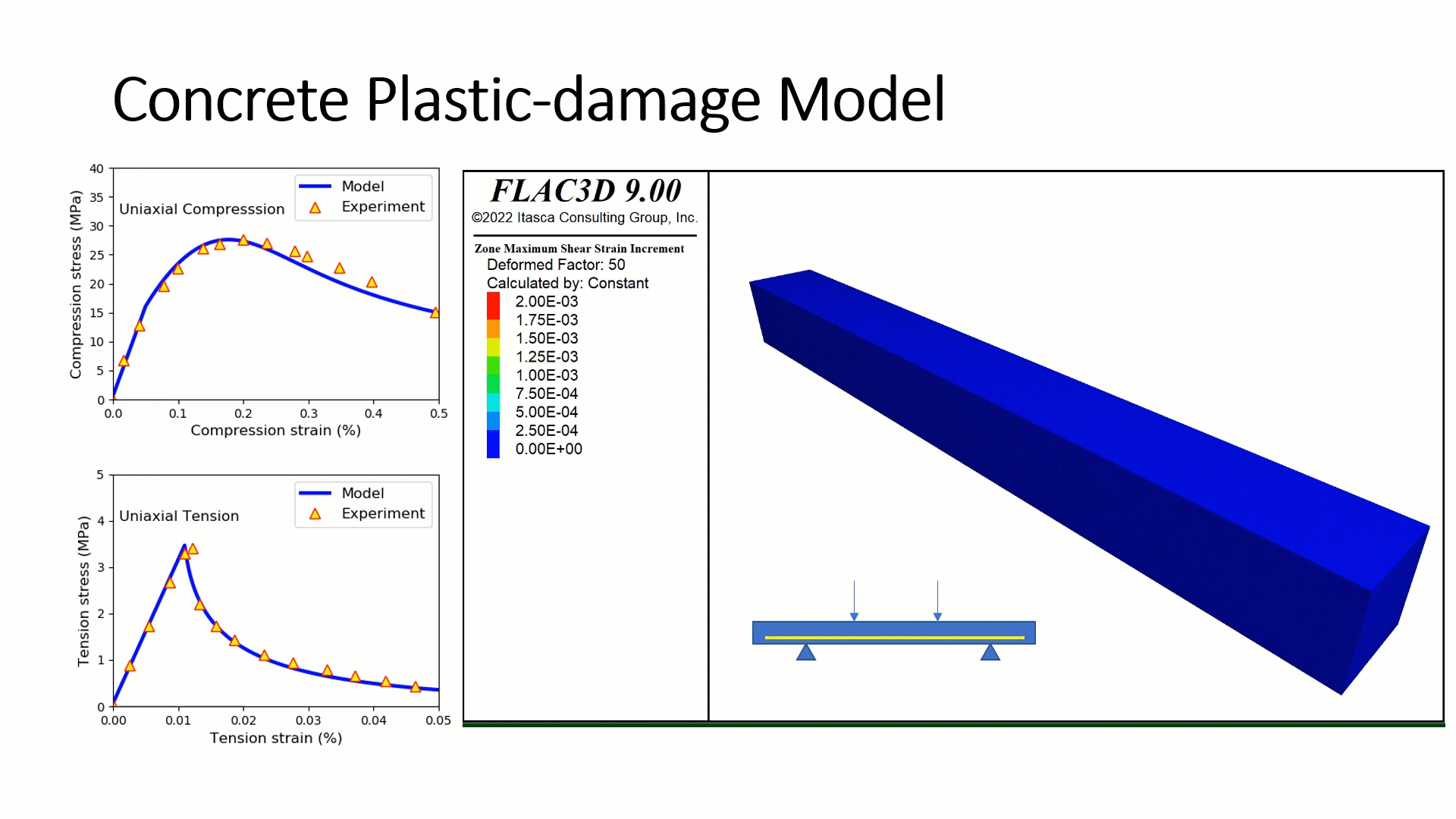IMPROVED USER INTERFACE
The most apparent difference between FLAC3D 7 and FLAC3D 9 is the improved user interface (UI). The UI consists of the Main Menu; the Project pane to view associated files and plots; the Command Console to input or view model commands and see model output or program messages (information/warnings/errors); the Content Workspace for creating new, and editing existing, data files, plots, sketch sets, geometry sets, building block sets, and the Model pane; the Contextual Tools/Help panel which changes depending on what has focus; the Layout Toggles to hide and show the the Project pane, Workspace, or Command Console; and the Status bar.
Use the Content Selector (the drop-down menu above the Content Workspace) to create plots, data files, sketch sets, or the work in the Model Pane. Then use the split icon (rectangle with a vertical line) to create new content to the left or right, or above or below the existing tile. This can be repeated for several levels of splitting. You may also double-click on certain file types listed in the Project Panel to bring them into the current tile. Each tile has it's own contextual tool bar. Easily manage your data files, sketch sets, saved model states, and hundreds of plots for working on real projects. Tiles can be closed by using X icon. This layout is saved with the Project.
Model execution (green arrow icon) and stop (red stop sign icon) now resides within the Text Editor and each data file making up the model.

EVEN FASTER
- FLAC3D 7 saw some impressive solution performance improvements over previous versions, but with FLAC3D 9 we've pushed this even further by optimizing the zone stiffness stability calculations:
- This makes static solutions converge approximately 40% faster when compared to FLAC3D 7
- The stable dynamic timestep for zones is now 2.6 times larger than in FLAC3D 7 (without structural elements/links)
- New Maxwell dynamic damping has been added for time-domain seismic deformation analyses. The numerical calculation time using Maxwell damping can be a small fraction of that required for Rayleigh damping (10-200 times faster), making large 3D site response and soil-structure interaction analyses practical.
- Implicit solvers for saturated-fluid flow and thermal calculations have been implemented for much faster analyses. For example, the new solver provided the same model response in 25 minutes that required 43 hours of modeling time in FLAC3D 7.
- Fast analytical temperature calculation for specified sources has been implemented.
- Point heat sources are placed either individually, or in lines and grids, to represent point, line or plane sources.
- Specifically oriented to solving design problems associated with nuclear waste disposal engineering.
- The ZGROUP plot-item was integrated into the main Zone plot-item and multi-threaded for 10 times faster plot generation.
- The saving/restoring algorithm has been improved for models with many groups/slots.
CONSTITUTIVE MODELS
Two existing constitutive models have also been improved:
- Ubiquitous-Anisotropic (CANISO)
- In addition to an anisotropic elastic matrix, a Mohr-Coulomb matrix option has been added.
- The joint behavior in both cases is based on a Mohr-Coulomb law
- Plastic-Hardening (PH)
- FLAC3D 7's implementation was based on the old Benz (2007) algorithm on small-strain hysteretic loop, which may not perform well on nested hysteretic loops (subjected to the so-called overshooting problem)
- FLAC3D 9's implementation is based on the new Brick algorithm.
- This update enables PH with small-strain flag to be used as a more practical dynamic model.
With the addition of three new constitutive models, FLAC3D now includes 27 built-in constitutive models, not including any options.
- Von-Mises
- For metal-like materials, both for solid zones or ground support structural elements.
- Optional kinematic hardening.
- Columnar-Basalt
- Accounts for the presence of up to four arbitrary orientations of weakness (ubiquitous joint) in a non-isotropic elastic matrix.
- Criterion for failure on the planes consists of a strain hardening/softening Mohr-Coulomb envelope with tension cutoff.
- Strain hardening/softening behavior can be specified (using a table) for joint cohesion, friction, dilation, and tension.
- An amplification factor can be applied to joint dilation that depends on the angle between a set direction.
- Creep on weak planes (with Creep Option)
- Concrete
- This concrete model is a plastic-damage model using the concepts of fracture-energy-based damage and modulus degradation in continuum damage mechanics.

Non-linear Structures
FLAC3D 9 introduces new non-linear structural elements for ground support for beam-type structures (beams and piles/rockbolts) and for shell-type structure (shells, geogrids, and liners).
Beam-Type Structures
- The beam-type plastic constitutive models update the internal element forces by integrating the internal stress over the beam volume using a numerical integration scheme. Stiffness matrices are not formed.
- The plasticity is induced by axial and bending deformations; twisting deformation induces an elastic response.
- The beam may have either a rectangular or circular cross section.
- Integration points are distributed throughout the volume of the beam elements.
- There are three beam plastic constitutive models, each of which is a one-dimensional version of the corresponding 3D model used by the zones:
- von Mises (steel beams)
- Mohr Coulomb (concrete beams)
- Strain Softening/Hardening Mohr Coulomb (concrete beams)
The following commands are for an rectangular cross-section aluminum ally beam:
struct beam cmodel assign von-mises
struct beam cmodel plastic-integration rectangular cross-section rectangular layout 3 5 3
struct beam property direction-y (0,1,0) young 68e9 poisson 0.33 strength-yield 270e6 modulus-plastic 0.0; 6061-T6 Al alloy

Shell-Type Structures
- The plastic constitutive models update the internal element forces by integrating the internal stress over the shell volume using a numerical integration scheme. Stiffness matrices are not formed.
- There are a group of integration points distributed throughout the volume of each shell element.
- There are three shell plastic constitutive models, each of which is a plane-stress version of the corresponding 3D model used by the zones:
- von Mises (steel shells)
- Mohr Coulomb (concrete shells)
- Strain Softening/Hardening Mohr Coulomb (concrete shells)
- Plasticity is provided by the DKT, CST and DKT-CST finite elements.

OTHER NEW CAPABILITIES
- Import pore pressures values to gridpoints from MINEDW *.mdp or CSV files (x, y, z, pore pressure)
- Updated Sketch (formerly Extruder) pane with background grid and ruler
- Ability to extrude a sketch along curves, as well as linearly (coming by Release)
- Define and interactive specify material property using the Model pane
- Built-in database to save/import/export material properties
- Plot-item improvements include:
- More attributes of contour plot including user-defined contour ramps
- Format (scientific/decimal) and precision of the contour legends can be specified
- Add option to swap axes for table and profile charts
- Add option to add minor gridlines to charts
- Improved logarithmic scale for charts
- Option to omit “past” states when plotting yield states
- More plots of contours (e.g., fos, fluid-head) and histories (e.g., structure node acceleration)
- Timoshenko keyword has been added to the structural pile command for modeling short thick beams
- The Ramberg-Osgood model has been added as one of several hysteretic damping options for dynamic modeling
- The UI can now detect if GPU support is enabled during Windows Remote Desktop connections to stop forcing ANGLE mode and to stop removing all plots
- All license types (standard/desktop, network, and web) now allow two instances per license on the same computer
- Python was updated to version 3.10.5
- The DEMONSTRATION version now allows up to 1,000 zone models to run
